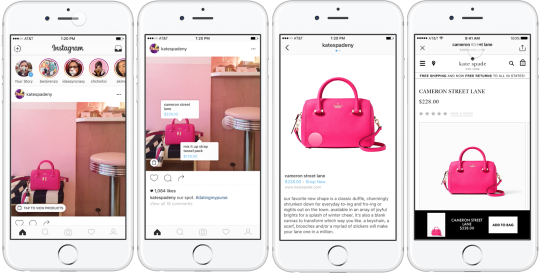Social media is predicted to reach 2.5 billion users this year, and a separate study by Demandware estimates that phones will account for 60 percent of eCommerce visits by the end of 2017. With so many turning to their mobile devices to research and share purchasing advice today, it’s no wonder the top social media sites are happy to make that process easier.
In 2015, Facebook added the ability to add shops to business pages. Since then, the social media giant has experimented with different, even more convenient, ways for users to shop without ever leaving the app. In addition to being a customer service outlet, Facebook Messenger has become a valuable resource for marketers, with users reaching one billion this past July. Messenger now accepts native payments, opening up possibilities for all-in-one discussion, customer service and booking. For its new payments feature, Facebook is working with a number of companies such as PayPal, Stripe, Visa, MasterCard, Braintree and American Express, which recently launched its own Facebook chat bot. The payment tool allows users to complete purchases in-app without going to an external site. Messenger users can also use credit card information they’ve stored in Messenger to make payments via bots.
A partnership with Fandango last year made it possible to purchase movie tickets directly from a feed, and now users can do the same with other events like museum exhibits and concerts.
Facebook-owned Instagram is also trying new ways to discover and purchase products and services through the platform. For paid ads, the site has implemented a full-width, call-to-action (CTA) button below an ad’s photo or video, replacing the overlay behavior and prior CTA design. In addition, Instagram has been experimenting with tags on business profiles that offer product info and prices. From there, a user can choose “Shop Now” to visit the product website outside of the app. “This functionality will bring important product information to the consumer earlier in the journey, all without having to leave the Instagram app to search,” Instagram explained in a blog post.

Pinterest is a unique animal, in that it’s a collection of ideas rather than the usual status updates you’d normally find on social media. Last June, the site unveiled its new Buyable Pins, shopping bag and store that enables users to purchase items directly from the site.
“An amazing 87 percent of Pinterest users have purchased something they found while using the platform,” Ayzenberg stated in its latest Earned Media Value Index Report. “Sharing is also an enormous component on the platform. 80 percent of content posted is a repin from another board, meaning there is a lot of opportunity for brands to get quality content (and the associated calls-to-action) distributed on other boards.”
Speaking at an event in June from the company’s headquarters, Pinterest executive Ben Silbermann explained, “Shopping with Pinterest is meant to be that bridge between getting inspiration and actually making it a part of your life.”
Snapchat
Quick to attract young consumers but late to the monetization party, Snapchat has been hard at work finding new ways to create lasting relationships between brands and would-be shoppers. While sponsored filters and interactive games certainly engage and entertain, there remains a gap between viewing a product and buying it.
The app’s latest efforts include interactive ads on its Discover section—inviting users to swipe up for product mini sites and calls-to-action—which were jump-started by brands Lancome and Target. Sweet, Hearst’s Snapchat channel, has partnered with Everlane to test a new, interactive way to engage shoppers on the platform. A project that appeared on November 8 encouraged Sweet Discover Page visitors to “draw” a monogram on an Everlane bag, then email a saved screenshot of the design to Everlane to purchase. Customers used Snapchat’s text and drawing tools to pick colors and monogram details as opposed to the traditional, drop-down or field selection method.
Ross Clark, vice president and general manager at Sweet, called the channel’s brand of interactive editorial “conversational content” and said it’s an approach Sweet has used to score firsts from brands such as Gucci and Carolina Herrera.

Twitter Says “Bye” To “Buy” Buttons
First appearing in 2014, Twitter’s “Buy” button allowed brands and non-profit organizations to include a call-to-action in its posts, thanks to a partnership with Shopify. Eight months ago, Twitter disbanded its commerce team and announced a new focus on website conversions. Now Shopify members are receiving notices that Twitter will phase out the “Buy” option, although donation buttons will still be offered for charitable causes.

